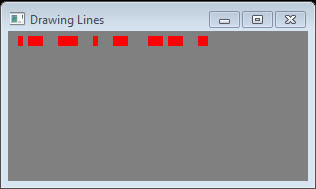JavaFX line
May 10, 2021 Java
Table of contents
JavaFX Tutorial - JavaFX Line
In order to render graphics on JavaFX scenes, we need basic shapes and colors.
Node
class is the basic base class for all JavaFX scene graphics nodes.
It provides the ability to transform, translate, and apply effects to any node.
javafx.scene.shape.Shape
is a descendant of the
Node
class.
All older JavaFX 2.x Builder classes are deprecated in JavaFX 8.
JavaFX line
When drawing on a JavaFX scene drawing, the line is rendered using screen coordinate space (system).
The screen coordinate system places (0,0) in the upper left corner.
The x coordinate moves the point along the x axis. When you move points from top to bottom, the y coordinate value increases.
The following image shows the screen coordinate system on the right.

In JavaFX, scene graphics objects, such as
lines, circles, and rectangles, are
Shape
classes of the Shape class.
All shape objects can perform geometric operations between two forming areas, such as subtract, intersect, and constrict.
To draw lines in JavaFX, we'll use
javafx.scene.shape.Line
class.
To create a
Line
we need to specify a start (x,y) and end coordinates.
When you create a line node, there are two ways to set the start and end points.
The first method uses constructors with parameters startX, startY, endX, and endY
All parameters have a data type
double
The following code uses constructors to create lines with a starting point (100,10) and an end point (10,110).
Line line = new Line(100, 10, 10, 110);
The second way to create a row node is
to instantiate the
Line class with an
Line
and then set each property using the setter method.
The following code shows how to create line objects and set the start and end points of lines using the setter method.
Line line = new Line();
line.setStartX(100);
line.setStartY(10);
line.setEndX(10);
line.setEndY(110);
The line node drawn on the scene map defaults to a stroke width of 1.0 and a black stroke color.
The stroke colors for all shapes are null, which means that there are no colors except the Line, Polyline, and Path nodes.
To create different kinds of lines, we can set properties inherited from the
javafx.scene.shape.Shape
The following table shows the properties that we can set on a row.
To retrieve or modify each property, you will use its appropriate getter and setter methods.
| Property | Data type / description |
|---|---|
| fill |
javafx.scene.paint.Paint
Used to fill colors within a shape. |
| smooth |
Boolean
True indicates that anti-aliasing is turned on, and false means that anti-aliasing is turned off. |
| strokeDashOffset |
Double
Set the distance to a dashed pattern. |
| strokeLineCap |
javafx.scene.shape.StrokeLineCap
Set the cap style online or at the end of the path. There are three styles:
|
| strokeLineJoin |
javafx.scene.shape.StrokeLineJoin
Set up decorations when lines meet. There are three types:
|
| strokeMiterLimit |
Double
Set the limits of the bevel seams and the bevel seams decorate TheStrokeLineJoin.MITER. |
| stroke |
javafx.scene.paint.Paint
Sets the color of the stroke of the shape. |
| strokeType |
javafx.scene.shape.StrokeType
Set the position where the stroke is drawn around the boundaries of the Shape node. There are three types:
|
| strokeWidth |
Double
Set the width of the line. |
Example
The following code creates a Line object and sets the start and end coordinates using the setter method.
import javafx.application.Application; import javafx.scene.Scene; import javafx.scene.layout.VBox; import javafx.scene.shape.Line; import javafx.stage.Stage; public class Main extends Application { @Override public void start(Stage stage) { VBox box = new VBox(); final Scene scene = new Scene(box,300, 250); scene.setFill(null); Line line = new Line(); line.setStartX(0.0f); line.setStartY(0.0f); line.setEndX(100.0f); line.setEndY(100.0f); box.getChildren().add(line); stage.setScene(scene); stage.show(); } public static void main(String[] args) { launch(args); } }
The code above produces the following results.

Example 2
The following code sets more line properties, including stroke color, stroke width, and line cap.
It then sets the dash style of the line.
import javafx.application.Application; import javafx.scene.Group; import javafx.scene.Scene; import javafx.scene.paint.Color; import javafx.scene.shape.Line; import javafx.scene.shape.StrokeLineCap; import javafx.stage.Stage; public class Main extends Application { @Override public void start(Stage primaryStage) { primaryStage.setTitle("Drawing Lines"); Group root = new Group(); Scene scene = new Scene(root, 300, 150, Color.GRAY); Line redLine = new Line(10, 10, 200, 10); redLine.setStroke(Color.RED); redLine.setStrokeWidth(10); redLine.setStrokeLineCap(StrokeLineCap.BUTT); redLine.getStrokeDashArray().addAll(15d, 5d, 15d, 15d, 20d); redLine.setStrokeDashOffset(10); root.getChildren().add(redLine); primaryStage.setScene(scene); primaryStage.show(); } public static void main(String[] args) { launch(args); } }
The code above produces the following results.
